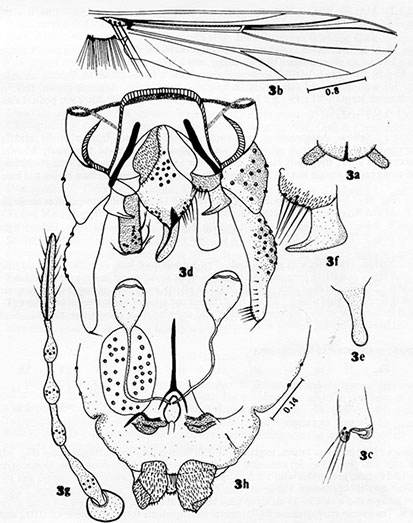C. indiaensis Martin 2011Description and metrics based on Chattopadhyay et al. (1991) This is potentially a member of the C. flaviplumus complex Adult:  Adult of C. indiaensis from Chattopadhyay et al. (1991) (as C. samoensis). Wing length about 2.53-2.58 mm, wing width 0.73-0.76, VR 1.02. AR 2.99. LR - 1.41; the fore Ta5 about 0.28 of the length of Ti. Brownish species; yellow thorax with brown vittae, abdomen light brown to brown with median grey spots. Legs yellow. Head: Frontal tubercles present, abt 180 µm; abt 23 - 25 clypeal setae. Palpal proportions (arbitrary units): 10 : 12 : 59 : 61 : 81. Thorax: Setae - Acrostichal 14; dorsolateral 11-12; prealar 6; scutellar in two or three rows, ant. row 9-10 small setae, post. rows 10-12 long setae. Leg proportions and ratios (arbitrary units):
Differs from C. samoensis where the frontal tubercles are longer (33-38 micron); the LR is greater (1.82-1.96); and the fore Ta5 is relatively longer (0.35-0.4 of the length of fore Ti). Wing length about 2.79-2.83 mm, wing width 0.76-0.77. AR 0.39. Antennal proportions: 13 : 9 : 8 : 8: 15. Necks of segments 2-4 about half of segment length; A5/A1 1.15. The description of the female does not mention the unusually long foreTa4 noted by Tokunaga (1964), as characteristic of C. samoensis. Pupa: Length 6.51 (5.99-6.61) µm in males, 7.21 (7.01-7.53) in females. Colour brown, but pupal exuviae pale brown. Frontal tubercles 75 µm long and 57 µm wide at base, subapical seta 39 µm long. Fourth instar larva: a small to medium plumosus type (8.41-9.83 mm), with anterior VT shorter than posterior pair; anal tubules tubular, about 340 µm long. The most obvious difference from the larva of C. samoensis is that antennal segment A4 of that species is longer than A3, while the relative lengths are reversed in this species. Cytology - not known. Found: West Bengal - Berhampur, Farakka, Burdwan. | ||||||||||||||||||||||||||||||||||||||||||||||||||||||||
Modified: 11 July 2022
Access: Unrestricted
Copyright © 2000-2022, Jon Martin.